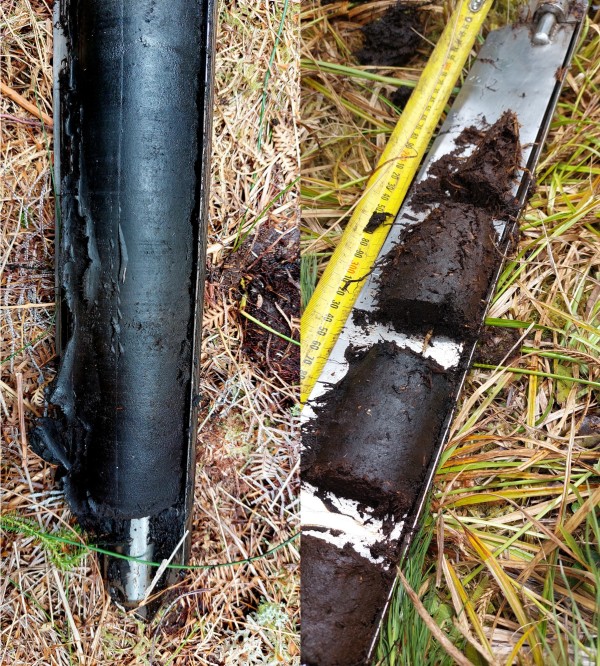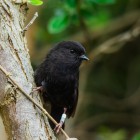
Blog and news
The potential of Chatham Island peatlands
Just how much carbon could Chatham Island peatlands hold? Masters research has started exploring the capacity for carbon sequestration in these valuable ecosystems, and the potential for alternative income for landowners.
Chatham Island peat
Thirty centimeters of healthy peat looks like delicious, rich chocolate mudcake. It’s moist and dense. However, eating it is not advised.
Peat is made up from layers and layers of historic plant matter, accumulating in damp conditions over a long period of time. Low levels of oxygen slow their decomposition dramatically. As this organic material compacts over time, it forms peatlands and bogs. These habitats are important for a range of species, both plant and animal, and provide important ecosystem services that contribute to a healthy environment.
What’s more, all those layers of carbon-rich plant matter store carbon that would otherwise be in our atmosphere.
That’s why a small group of researchers, including a Masters student from the Netherlands and a scientist with a lifelong passion for the islands, found themselves kneeling in the damp to take core samples of precious soil in the remote Chatham Islands.

A dracophyllum and sporadanthus bog with macrolearia on the Southern Tablelands. Image: Peter de Lange.
What’s the deal with peatlands?
On the Chathams, peatlands account for approximately 42,000ha of the land. Over half the island is peat. A type of wetland, peatlands are habitats for a variety of unique species and provide ecosystem services that keep the environment healthy.
Globally, peatlands store twice the amount of carbon that forests do. This potential has led to many countries including carbon credits from peatlands on the open carbon market. The United Kingdom’s voluntary Peatland Code is a good example.
If New Zealand were to adopt something similar, it could help protect these areas while providing landowners with a passive income from land that’s generally unproductive for farming and other agriculture. But before this can happen, it’s important to have scientific data on just how much carbon peatlands can store.

Kaeli Lalor and Rabia Sheikh peat core sampling.
Taking peatland samples
Last year, research to start quantifying carbon stocks in Chatham peatlands took the form of a Masters research project by Rabia Sheikh (Radboud University, Netherlands). The research, completed earlier this year, was funded through the Essential Freshwater Fund and supported by Agri Concepts and the Nature Conservancy. Botanist Peter de Lange, Hamish Chisholm from the Chatham Islands Landscape Restoration Trust, Rob Chappell from the Chatham Island Conservation Board, and other landowners and conservationists also provided support – especially in the field.
Rabia described how it was important to compare peatlands in different states – areas that have been drained or are currently being grazed, and areas that have been fenced to keep livestock off.
Seven sites were identified on main Chatham to give a fair variety of samples, and Rabia, Peter, and a small team put on their gumboots and went into the field. They took samples by pushing a hollow tube called a ‘core’ into the soil, then drawing it back out. This provides a cylindrical section of peat, in this case 30cm long.

Two core samples from Chatham wetlands; healthy on the left, and degraded on the right. Image: Peter de Lange
There were some marked differences in the samples they took.
“Water content is important,” Rabia said. In stock-excluded sites, she could squeeze the soil and watch the water come out; in unprotected sites, the soil was dry and brittle and just crumbled.
“Some areas were too dry to use the core. We had to use a spade instead, because the core couldn’t go into the ground. In one area the core we took out was just beige clay, so we had to go to another area of the peatland to get a sample.”
Colour is another indicator. In the unprotected peatlands, the samples tended to be lighter in colour and crumbly, like those described above. In the protected areas, the samples were dark and compact – the mudcake effect.
These samples, effectively being cross-sections of what’s happening under the surface, also show different layers. These layers, usually indicated by texture and colour, tell a lot about the history and present of the area.
“A good indication of a healthy peatland is the active layer that shows up in a core sample,” Rabia said.
This active layer is where the process of forming peat is still underway, so it’s more fibrous as plants – like Dracophyllum scoparium and Sporadanthus traversii – are still decomposing. Effectively, she said, it’s still going through the process of forming and storing carbon.

Dracophyllum scoparium in flower. Image: Peter de Lange.
Quantifying the carbon
The core samples were exported to Landcare Research for analysis of total organic carbon and nitrogen.
The results showed that protected sites had the thickest active layer, of around 10-20cm, while unprotected sites had a very thin active layer that was no more than 5cm.
“This is because, with livestock there and trampling taking place, there’s no chance for the layer to form and grow over time.” It’s that slow buildup and compression of the plant matter that is characteristic of a healthy peatland.
When analysing how much carbon was in the protected and unprotected peatland samples, Rabia found a result that initially surprised her.
“The results showed that there was more carbon present in the samples from the unprotected peatland than the protected peatland. At a glance, this seems to be converse to what you’d expect.
“However, this is due to the proportion of the active layer in a 30cm sample size. The thicker active layer has less carbon in it than the older layers. Those older layers are densely compressed, formed over decades and decades of plant matter decomposing, and they hold a lot more carbon.”
The larger active layers show the protected areas forming new peat more quickly than the ones that aren’t protected. And because that thick active layer helps protect the older, carbon-rich layers beneath, it means those older layers are less likely to be released into the atmosphere by disturbance.

Female sporadanthus traversii. Image: Peter de Lange.
The potential of peatlands
This is just the very first step in understanding – and then using – the potential of peatlands in the Chathams.
Rabia says more research is needed about the accumulation rates or, in other words, how quickly a layer of peat forms in a specific peatland. Other research has shown similarities between Waikato and the Chathams when it comes to accumulation rates. In Waikato, protected peatlands increase an average 1.9cm every year.
She also highlighted how quickly peatlands can begin to recover, with the right protections. She cited one landowner who decided to give up attempting to farm on an area of peat. Within 15 years, they noticed a significant return of the vegetation.
Funding is being sought to continue researching the function of these peatland ecosystems. This could allow them to explore opportunities for peatlands to be included on the open carbon market, using the carbon credit system.
“People don’t realise how important peatlands are, and how much potential these wetlands have,” Rabia says.

Rabia Sheikh peat core sampling.
A personal note from Rabia
Rabia’s academic careers started off with a course in the Netherlands, focused on nature in a crowded country. She learned about wetlands during this study, and ended up writing a paper on how New Zealand is tackling climate change. She was particularly interested in New Zealand’s focus on nature-based solutions.
From here, Rabia found out about the Nature Conservancy’s Blue Carbon project. This led to her doing her Master’s thesis in Aotearoa, with lots of support from the Nature Conservancy and her university in the Netherlands. She focused on the Chatham Islands, and carried out field work for the first time.
When asked what she liked, she laughed and said “What didn’t I like? The people are so welcoming and kind and generous. This island is so beautiful.” She enjoyed having conservations with the landowners, and appreciated how interested and curious people were about her work.
It’s an experience she’ll never forget. “It feels like you’re in the middle of the ocean. Isolated and there’s something so peaceful about that.”
Special thanks to all those mentioned in this blog, including Peter de Lange, Rob Chappell, Hamish Tuanui-Chisholm, as well as Kopinga Marae and Deb, Alfred Preece, Bruce and Liz Tuanui, Ruka Lanauze and Celine Gregory-Hunt, Tony Anderson, Milly Farquhar, Ruby Mulinder, and Olya from the Nature Conservancy.


